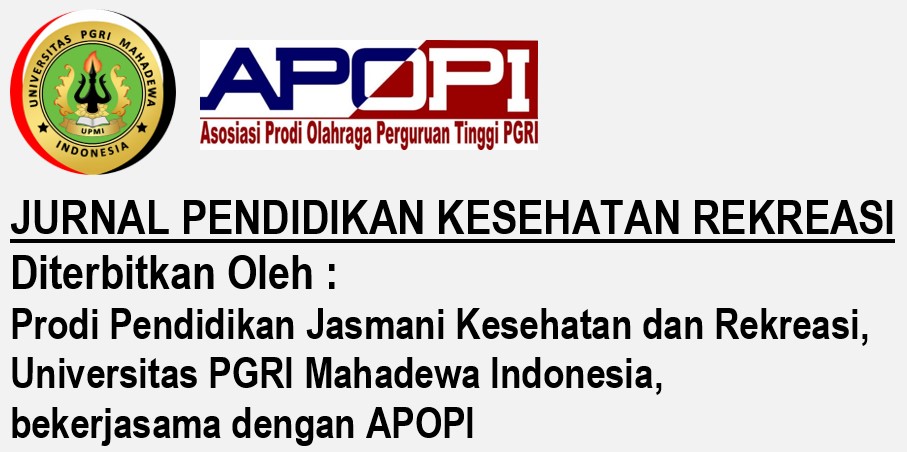Hasil Latihan Intensitas 75% Kemampuan Repetisi Maksimal terhadap Berat Badan
DOI:
https://doi.org/10.5281/zenodo.4895768Keywords:
intensitas 75%, penurunan berat badan, latihanAbstract
Banyak orang melakukan aktivitas jasmani dan olahraga untuk menjaga kebugaran. Ada orang tertentu melakukan program diet untuk menurunkan berat badan dengan gym, senam, olahraga tertentu, jogging, naik sepeda dan berenang. Isu yang dipertentangkan adalah tentang intensitas latihan. Penelitian ini mencoba untuk menggali informasi dengan melakukan eksperimen tentang pengaruh intensitas latihan terhadap penurunan berat badan dengan desain single subject desaigns, secara khusus desain penelitian adalah Group Experimental Designs AB. Sampel 6 mahasiswa dengan rentang umur 20-22 tahun. Treatment yang dilakukan dengan latihan beban dengan intensitas 75% (Medium) 10 station. Alat tersebut adalah tricep extention, leg press, pull down, calf raise, butterfly, leg extention, bench press, sit up, back up, dan standing rowing. Pengukuran dilakukan terhadap berat badan sebelum dan setelah latihan. Analisis data dengan deskriptif statistik. Hasil penelitian menunjukan bahwa selalu terjadi penurunan berat badan setelah latihan sebesar 0,26 kg per kali latihan. Setiap memulai latihan ada yang mengalami penurunan, kembali ke asal pada kondisi semula, ada yang tetap dan ada yang turun. Sehingga dapat disimpulkan latihan dapat menurunkan berat badan, variabel asupan gizi makro setelah latihan menentukan keberhasilan dalam pelaksanaan penurunan berat badan.
Downloads
References
Adiatmika, I. P. G., & Santika, I. G. P. N. A. (2016). Bahan Ajar Tes dan Pengukuran Olahraga. Denpasar : Udayana University Press
Afrasyabi, S., Marandi, S. M., & Kargarfard, M. (2019). The effects of high intensity interval training on appetite management in individuals with type 2 diabetes: influenced by participants weight. Journal of Diabetes and Metabolic Disorders, 15(18), 107–117. https://doi.org/10.1007/s40200-019-00396-0
Álvarez, C., Ramírez-Campillo, R., Ramírez-Vélez, R., Martínez, C., Castro-Sepúlveda, M., Alonso-Martínez, A., & Izquierdo, M. (2018). Metabolic effects of resistance or high-intensity interval training among glycemic control-nonresponsive children with insulin resistance. International Journal of Obesity. https://doi.org/10.1038/ijo.2017.177
Andreato, L. V., Esteves, J. V., Coimbra, D. R., Moraes, A. J. P., & de Carvalho, T. (2019). The influence of high-intensity interval training on anthropometric variables of adults with overweight or obesity: a systematic review and network meta-analysis. Obesity Reviews, 20(1), 142–155. https://doi.org/10.1111/obr.12766
Bompa, T. O., & Buzzichelli, C. A. (2019). Peridization: Theory and Methodology of Training. Journal of Chemical Information and Modeling.
Campbell, W. W., Kraus, W. E., Powell, K. E., Haskell, W. L., Janz, K. F., Jakicic, J. M., … Bartlett, D. B. (2019). High-Intensity Interval Training for Cardiometabolic Disease Prevention. Medicine and Science in Sports and Exercise, 51(6), 1220–1226. https://doi.org/10.1249/MSS.0000000000001934
Chuensiri, N., Suksom, D., & Tanaka, H. (2018). Effects of High-Intensity Intermittent Training on Vascular Function in Obese Preadolescent Boys. Childhood Obesity. https://doi.org/10.1089/chi.2017.0024
Clark, T., Morey, R., Jones, M. D., Marcos, L., Ristov, M., Ram, A., … Keech, A. (2020). High-intensity interval training for reducing blood pressure: a randomized trial vs. moderate-intensity continuous training in males with overweight or obesity. Hypertension Research, 40(35), 396–403. https://doi.org/10.1038/s41440-019-0392-6
Cvetković, N., Stojanović, E., Stojiljković, N., Nikolić, D., Scanlan, A. T., & Milanović, Z. (2018). Exercise training in overweight and obese children: Recreational football and high-intensity interval training provide similar benefits to physical fitness. Scandinavian Journal of Medicine and Science in Sports. https://doi.org/10.1111/sms.13241
De Lira, C. T. C., dos Santos, M. A. M., Gomes, P. P., Fidelix, Y. L., dos Santos, A. C. O., Tenório, T. R. S., … do Prado, W. L. (2017). Aerobic training performed at ventilatory threshold improves liver enzymes and lipid profile related to non-alcoholic fatty liver disease in adolescents with obesity. Nutrition and Health, 23(4), 281–288. https://doi.org/10.1177/0260106017720350
De Lorenzo, A., Van Bavel, D., De Moraes, R., & Tibiriça, E. V. (2018). High-intensity interval training or continuous training, combined or not with fasting, in obese or overweight women with cardiometabolic risk factors: Study protocol for a randomised clinical trial. BMJ Open, 8(4), e019304. https://doi.org/10.1136/bmjopen-2017-019304
De Matos, M. A., Garcia, B. C. C., Vieira, D. V., de Oliveira, M. F. A., Costa, K. B., Aguiar, P. F., … Rocha-Vieira, E. (2019). High-intensity interval training reduces monocyte activation in obese adults. Brain, Behavior, and Immunity, 80, 818–824. https://doi.org/10.1016/j.bbi.2019.05.030
De Matos, M. A., Vieira, D. V., Pinhal, K. C., Lopes, J. F., Dias-Peixoto, M. F., Pauli, J. R., … Amorim, F. T. (2018). High-intensity interval training improves markers of oxidative metabolism in skeletal muscle of individuals with obesity and insulin resistance. Frontiers in Physiology, 31(9), 1451. https://doi.org/10.3389/fphys.2018.01451
De Strijcker, D., Lapauw, B., Ouwens, D. M., Van de Velde, D., Hansen, D., Petrovic, M., … Calders, P. (2018). High intensity interval training is associated with greater impact on physical fitness, insulin sensitivity and muscle mitochondrial content in males with overweight/obesity, as opposed to continuous endurance training: A randomized controlled trial. Journal of Musculoskeletal Neuronal Interactions.
Dias, K. A., Ingul, C. B., Tjønna, A. E., Keating, S. E., Gomersall, S. R., Follestad, T., … Coombes, J. S. (2018). Effect of High-Intensity Interval Training on Fitness, Fat Mass and Cardiometabolic Biomarkers in Children with Obesity: A Randomised Controlled Trial. Sports Medicine. https://doi.org/10.1007/s40279-017-0777-0
Eddolls, W. T. B., McNarry, M. A., Stratton, G., Winn, C. O. N., & Mackintosh, K. A. (2017). High-Intensity Interval Training Interventions in Children and Adolescents: A Systematic Review. Sports Medicine, 47(11), High-Intensity Interval Training Interventions in. https://doi.org/10.1007/s40279-017-0753-8
Fernandes, I. M. da C., Pinto, R. Z., Ferreira, P., & Lira, F. S. (2018). Low back pain, obesity, and inflammatory markers: Exercise as potential treatment. Journal of Exercise Rehabilitation. https://doi.org/10.12965/jer.1836070.035
García-Hermoso, A., Cerrillo-Urbina, A. J., Herrera-Valenzuela, T., Cristi-Montero, C., Saavedra, J. M., & Martínez-Vizcaíno, V. (2016). Is high-intensity interval training more effective on improving cardiometabolic risk and aerobic capacity than other forms of exercise in overweight and obese youth? A meta-analysis. Obesity Reviews, 17(6), 531–540. https://doi.org/10.1111/obr.12395
Gerosa-Neto, J., Antunes, B. M. M., Campos, E. Z., Rodrigues, J., Ferrari, G. D., Neto, J. C. R., … Lira, F. S. (2016). Impact of long-term high-intensity interval and moderate-intensity continuous training on subclinical inflammation in overweight/obese adults. Journal of Exercise Rehabilitation, 12(6), 575–580. https://doi.org/10.12965/jer.1632770.385
Hay, J., Wittmeier, K., MacIntosh, A., Wicklow, B., Duhamel, T., Sellers, E., … McGavock, J. (2016). Physical activity intensity and type 2 diabetes risk in overweight youth: A randomized trial. International Journal of Obesity, 40(4), 607–614. https://doi.org/10.1038/ijo.2015.241
Herring, L. Y., Stevinson, C., Carter, P., Biddle, S. J. H., Bowrey, D., Sutton, C., & Davies, M. J. (2017). The effects of supervised exercise training 12-24 months after bariatric surgery on physical function and body composition: A randomised controlled trial. International Journal of Obesity, 41(4), 909–916. https://doi.org/10.1038/ijo.2017.60
Hunter, G. R., Plaisance, E. P., Carter, S. J., & Fisher, G. (2018). Why intensity is not a bad word: Optimizing health status at any age. Clinical Nutrition. https://doi.org/10.1016/j.clnu.2017.02.004
Ingul, C. B., Dias, K. A., Tjonna, A. E., Follestad, T., Hosseini, M. S., Timilsina, A. S., … Coombes, J. S. (2018). Effect of High Intensity Interval Training on Cardiac Function in Children with Obesity: A Randomised Controlled Trial. Progress in Cardiovascular Diseases, 61(2), 214–221. https://doi.org/10.1016/j.pcad.2018.01.012
Irianto, D. P. (2017). Pedoman gizi lengkap keluarga dan olahragawan. (Yeskha, Ed.) (Edisi Revi). Yogyakarta: Penerbit Andi.
Kargarfard, M., Lam, E. T. C., Shariat, A., Asle Mohammadi, M., Afrasiabi, S., Shaw, I., & Shaw, B. S. (2016). Effects of endurance and high intensity training on ICAM-1 and VCAM-1 levels and arterial pressure in obese and normal weight adolescents. Physician and Sportsmedicine, 44(3), 208–216. https://doi.org/10.1080/00913847.2016.1200442
Kirwan, J. P., Sacks, J., & Nieuwoudt, S. (2017). The essential role of exercise in the management of type 2 diabetes. Cleveland Clinic Journal of Medicine, 84(7 suplement 1), S15–S21. https://doi.org/10.3949/ccjm.84.s1.03
Koh, Y., Park, J., & Carter, R. (2018). Oxidized Low-Density Lipoprotein and Cell Adhesion Molecules Following Exercise Training. International Journal of Sports Medicine, 39(2), 83-88. https://doi.org/10.1055/s-0043-118848
Lauralee Sherwood. (2001). Fisiologi Manusia dari Sel Sistem (Human Fhysiology: From Cells to Systems) (Pertama). Jakarta: Penerbit Buku Kedokteran EGC.
Magalhães, J. P., Júdice, P. B., Ribeiro, R., Andrade, R., Raposo, J., Dores, H., … Sardinha, L. B. (2019). Effectiveness of high-intensity interval training combined with resistance training versus continuous moderate-intensity training combined with resistance training in patients with type 2 diabetes: A one-year randomized controlled trial. Diabetes, Obesity and Metabolism, 21(3), 550–559. https://doi.org/10.1111/dom.13551
Moienneia, N., & Attarzadeh Hosseini, S. R. (2016). Acute and chronic responses of metabolic myokine to different intensities of exercise in sedentary young women. Obesity Medicine, 1, 15–20. https://doi.org/10.1016/j.obmed.2015.12.002
Normandin, E., Chmelo, E., Lyles, M. F., Marsh, A. P., & Nicklas, B. J. (2017). Effect of Resistance Training and Caloric Restriction on the Metabolic Syndrome. Medicine and Science in Sports and Exercise, 49(3), 413–419. https://doi.org/10.1249/MSS.0000000000001122
Obert, J., Pearlman, M., Obert, L., & Chapin, S. (2017). Popular Weight Loss Strategies: a Review of Four Weight Loss Techniques. Current Gastroenterology Reports, 19(12), 61. https://doi.org/10.1007/s11894-017-0603-8
Osiński, W., & Kantanista, A. (2017). Physical activity in the therapy of overweight and obesity in children and adolescents. Needs and recommendations for intervention programs. Developmental Period Medicine, 21(3), 224–234.
Ouerghi, N., Ben Fradj, M. K., Bezrati, I., Feki, M., Kaabachi, N., & Bouassida, A. (2017). Effect of High-Intensity Interval Training on Plasma Omentin-1 Concentration in Overweight/Obese and Normal-Weight Youth. Obesity Facts, 10(4), 323–331. https://doi.org/10.1159/000471882
Petridou, A., Siopi, A., & Mougios, V. (2019). Exercise in the management of obesity. Metabolism: Clinical and Experimental, 92, 163–169. https://doi.org/10.1016/j.metabol.2018.10.009
Piyana, P. D., Subekti, M., & Santika, . I. G. P. N. A. (2020). Pelatihan Hanging Leg Raise Terhadap Kekuatan Otot Perut. PENJAGA : Pendidikan Jasmani &Amp; Olahraga, 1(1), 7–11. Retrieved from https://jurnal.stkippgritrenggalek.ac.id/index.php/penjaga/article/view/58
Plavsic, L., Knezevic, O. M., Sovtic, A., Minic, P., Vukovic, R., Mazibrada, I., … Macut, D. (2020). Effects of high-intensity interval training and nutrition advice on cardiometabolic markers and aerobic fitness in adolescent girls with obesity. Applied Physiology, Nutrition and Metabolism, 45(3), 294–300. https://doi.org/10.1139/apnm-2019-0137
Ram, A., Marcos, L., Jones, M. D., Morey, R., Hakansson, S., Clark, T., … Keech, A. (2020). The effect of high-intensity interval training and moderate-intensity continuous training on aerobic fitness and body composition in males with overweight or obesity: A randomized trial. Obesity Medicine, 17, 100187. https://doi.org/10.1016/j.obmed.2020.100187
Santika, I. G. P. N. A. (2015). Hubungan Indeks Massa Tubuh (IMT) Dan Umur Terhadap Daya Tahan Umum (Kardiovaskuler) Mahasiswa Putra Semester II Kelas A Fakultas Pendidikan Olahraga Dan Kesehatan IKIP PGRI Bali Tahun 2014. Jurnal Pendidikan Kesehatan Rekreasi, 1(1), 42-47. Retrieved from https://ojs.mahadewa.ac.id/index.php/jpkr/article/view/6
Santika, I. G. P. N. A. (2016). Pengukuran Tingkat Kadar Lemak Tubuh Melalui Jogging Selama 30 Menit Mahasiswa Putra Semester IV FPOK IKIP PGRI Bali Tahun 2016. Jurnal Pendidikan Kesehatan Rekreasi, 2(1), 89-98. Retrieved from https://ojs.mahadewa.ac.id/index.php/jpkr/article/view/165 (Original work published June 30, 2016)
Santika, I. G. P. N. A. (2017). Pengukuran Komponen Biomotorik Mahasiswa Putra Semester V Kelas A Fakultas Pendidikan Olahraga Dan Kesehatan IKIP PGRI Bali Tahun 2017. Jurnal Pendidikan Kesehatan Rekreasi, 3(1), 85-92. Retrieved from https://ojs.mahadewa.ac.id/index.php/jpkr/article/view/221
Santika, I. G. P. N. A., Adiatmika, I. P. G., & Subekti, M. (2020). Training Of Run Star For Agility Volleyball Athlete Junior High School 2 Denpasar. Jp.Jok (Jurnal Pendidikan Jasmani, Olahraga Dan Kesehatan), 4(1), 128-141. https://doi.org/10.33503/jp.jok.v4i1.1137
Santika, I. G. P. N. A., Pranata, I. K. Y. (2020). Efektifitas Pelatihan Jogging Sprint Combination Terhadap Tingkat Kadar Lemak Siswa. Prosiding Seminar Nasional IPTEK Olahraga (SENALOG), 3(1), Kepelatihan-Or 01. Retrieved from https://ejournal.unibabwi.ac.id/index.php/semnassenalog/article/view/1083
Santika, I. G. P. N. A., Pranata, I. K. Y., & Festiawan, R. (2020). The Effectiveness of Jogging Sprint Combination Training on Students Fat Levels. Journal of Physical Education Health and Sport, 7(2), 43-38. https://journal.unnes.ac.id/nju/index.php/jpehs/article/view/27020
Shepherd, J. (2005). Training for SPEED, POWER & STRENGTH. (I. Walker, Ed.). London: Jonathan A. Pye.
Soh, S. H., Joo, M. C., Yun, N. R., & Kim, M. S. (2020). Randomized Controlled Trial of the Lateral Push-Off Skater Exercise for High-Intensity Interval Training vs Conventional Treadmill Training. Archives of Physical Medicine and Rehabilitation, 101(2), 187–195. https://doi.org/10.1016/j.apmr.2019.08.480
Su, L. Q., Fu, J. M., Sun, S. L., Zhao, G. G., Cheng, W., Dou, C. C., & Quan, M. H. (2019). Effects of HIIT and MICT on cardiovascular risk factors in adults with overweight and/or obesity: A meta-analysis. PLoS ONE, 14(1), e0210644. https://doi.org/10.1371/journal.pone.0210644
Tan, S., Chen, C., Sui, M., Xue, L., & Wang, J. (2017). Exercise training improved body composition, cardiovascular function, and physical fitness of 5-year-old children with obesity or normal body mass. Pediatric Exercise Science, 29(2), 245–253. https://doi.org/10.1123/pes.2016-0107
Tan, S., Wang, J., Cao, L., Guo, Z., & Wang, Y. (2016). Positive effect of exercise training at maximal fat oxidation intensity on body composition and lipid metabolism in overweight middle-aged women. Clinical Physiology and Functional Imaging, 36(3), 225–230. https://doi.org/10.1111/cpf.12217
Tirtayasa, P. K. R., Santika, I. G. P. N. A., Subekti, M., Adiatmika, I. P. G., & Festiawan, R. (2020). Barrier Jump Training to Leg Muscle Explosive Power. Jurnal ACTIVE : Jurnal of Physical Education, Sport, Health and Recreation, 9(3), 173-177. https://journal.unnes.ac.id/sju/index.php/peshr/article/view/41145
Turk, Y., Theel, W., Kasteleyn, M. J., Franssen, F. M. E., Hiemstra, P. S., Rudolphus, A., … Braunstahl, G. J. (2017). High intensity training in obesity: a Meta-analysis. Obesity Science and Practice, 3(3), 258–271. https://doi.org/10.1002/osp4.109
Wewege, M., van den Berg, R., Ward, R. E., & Keech, A. (2017). The effects of high-intensity interval training vs. moderate-intensity continuous training on body composition in overweight and obese adults: a systematic review and meta-analysis. Obesity Reviews, 18(6), 635–646. https://doi.org/10.1111/obr.12532
Winding, K. M., Munch, G. W., Iepsen, U. W., Van Hall, G., Pedersen, B. K., & Mortensen, S. P. (2018). The effect on glycaemic control of low-volume high-intensity interval training versus endurance training in individuals with type 2 diabetes. Diabetes, Obesity and Metabolism, 20(5), 1131–1139. https://doi.org/10.1111/dom.13198
Wormgoor, S. G., Dalleck, L. C., Zinn, C., & Harris, N. K. (2017). Effects of High-Intensity Interval Training on People Living with Type 2 Diabetes: A Narrative Review. Canadian Journal of Diabetes, 41(5), 536–547. https://doi.org/10.1016/j.jcjd.2016.12.004
Zhang, H., Tong, T. K., Qiu, W., Zhang, X., Zhou, S., Liu, Y., & He, Y. (2017). Comparable Effects of High-Intensity Interval Training and Prolonged Continuous Exercise Training on Abdominal Visceral Fat Reduction in Obese Young Women. Journal of Diabetes Research, 2017:5071740. https://doi.org/10.1155/2017/5071740
Zouhal, H., Ben Abderrahman, A., Khodamoradi, A., Saeidi, A., Jayavel, A., Hackney, A. C., … Jabbour, G. (2020). Effects of physical training on anthropometrics, physical and physiological capacities in individuals with obesity: A systematic review. Obesity Reviews, 21(9), e13039. https://doi.org/10.1111/obr.13039
Downloads
Published
How to Cite
Issue
Section
License
Copyright (c) 2021 Jurnal Pendidikan Kesehatan Rekreasi

This work is licensed under a Creative Commons Attribution-NonCommercial-ShareAlike 4.0 International License.
Jurnal Pendidikan Kesehatan Rekreasi is published under the terms of Creative Commons Attribution 4.0 International License / CC BY NC SA 4.0. This license permits others to copy, distribute, modify, and create derivative works for non-commercial purposes only


































